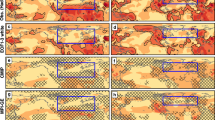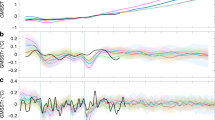Abstract
Global mean surface warming over the past 15 years or so has been less than in earlier decades and than simulated by most climate models1. Natural variability2,3,4, a reduced radiative forcing5,6,7, a smaller warming response to atmospheric carbon dioxide concentrations8,9 and coverage bias in the observations10 have been identified as potential causes. However, the explanations of the so-called ‘warming hiatus’ remain fragmented and the implications for long-term temperature projections are unclear. Here we estimate the contribution of internal variability associated with the El Niño/Southern Oscillation (ENSO) using segments of unforced climate model control simulations that match the observed climate variability. We find that ENSO variability analogous to that between 1997 or 1998 and 2012 leads to a cooling trend of about −0.06 °C. In addition, updated solar and stratospheric aerosol forcings from observations explain a cooling trend of similar magnitude (−0.07 °C). Accounting for these adjusted trends we show that a climate model of reduced complexity with a transient climate response of about 1.8 °C is consistent with the temperature record of the past 15 years, as is the ensemble mean of the models in the Coupled Model Intercomparison Project Phase 5 (CMIP5). We conclude that there is little evidence for a systematic overestimation of the temperature response to increasing atmospheric CO2 concentrations in the CMIP5 ensemble.
This is a preview of subscription content, access via your institution
Access options
Subscribe to this journal
Receive 12 print issues and online access
$259.00 per year
only $21.58 per issue
Buy this article
- Purchase on Springer Link
- Instant access to full article PDF
Prices may be subject to local taxes which are calculated during checkout



Similar content being viewed by others
References
IPCC, in Climate Change 2013: The Physical Science Basis (eds Stocker, T. F. et al.) (Cambridge Univ. Press, 2013).
Kosaka, Y. & Xie, S. P. Recent global-warming hiatus tied to equatorial Pacific surface cooling. Nature 501, 403–407 (2013).
Meehl, G. A., Arblaster, J. M., Fasullo, J. T., Hu, A. X. & Trenberth, K. E. Model-based evidence of deep-ocean heat uptake during surface-temperature hiatus periods. Nature Clim. Change 1, 360–364 (2011).
Meehl, G. A., Hu, A. X., Arblaster, J. M., Fasullo, J. & Trenberth, K. E. Externally forced and internally generated decadal climate variability associated with the interdecadal Pacific oscillation. J. Clim. 26, 7298–7310 (2013).
Solomon, S. et al. The persistently variable ‘Background’ stratospheric aerosol layer and global climate change. Science 333, 866–870 (2011).
Santer, B. D. et al. Volcanic contribution to decadal changes in tropospheric temperature. Nature Geosci. 7, 185–189 (2014).
Fyfe, J. C., von Salzen, K., Cole, J. N. S., Gillett, N. P. & Vernier, J. P. Surface response to stratospheric aerosol changes in a coupled atmosphere-ocean model. Geophys. Res. Lett. 40, 584–588 (2013).
Lewis, N. An objective Bayesian, improved approach for applying optimal fingerprint techniques to estimate climate sensitivity. J. Clim. 26, 7414–7249 (2013).
Aldrin, M. et al. Bayesian estimation of climate sensitivity based on a simple climate model fitted to observations of hemispheric temperatures and global ocean heat content. Environmetrics 23, 253–271 (2012).
Cowtan, K. & Way, R. G. Coverage bias in the HadCRUT4 temperature series and its impact on recent temperature trends. Q. J. R. Meteorol. Soc. 10.1002/qj.2297 (2014)
Schmidt, G. A., Shindell, D. T. & Tsigaridis, K. Reconciling warming trends. Nature Geosci. 7, 158–160 (2014).
Rahmstorf, S., Foster, G. & Cazenave, A. Comparing climate projections to observations up to 2011. Environ. Res. Lett. 7, 044035 (2012).
England, M. H. et al. Recent intensification of wind-driven circulation in the Pacific and the ongoing warming hiatus. Nature Clim. Change 4, 222–227 (2014).
Trenberth, K. E. & Fasullo, J. T. An apparent hiatus in global warming? Earth’s Future 1, 19–32 (2013).
Frohlich, C. Total solar irradiance observations. Surv. Geophys. 33, 453–473 (2012).
Otto, A. et al. Energy budget constraints on climate response. Nature Geosci. 6, 415–416 (2013).
Gillett, N. P., Arora, V. K., Flato, G. M., Scinocca, J. F. & von Salzen, K. Improved constraints on 21st-century warming derived using 160 years of temperature observations. Geophys. Res. Lett. 39, L01704 (2012).
Knutti, R. & Hegerl, G. C. The equilibrium sensitivity of the Earth’s temperature to radiation changes. Nature Geosci. 1, 735–743 (2008).
Hansen, J. et al. Efficacy of climate forcings. J. Geophys. Res. 110, D18104 (2005).
Shindell, D. T. Inhomogeneous forcing and transient climate sensitivity. Nature Clim. Change 4, 274–277 (2014).
Thompson, D. W. J., Wallace, J. M., Jones, P. D. & Kennedy, J. J. Identifying signatures of natural climate variability in time series of global-mean surface temperature: Methodology and insights. J. Clim. 22, 6120–6141 (2009).
Fischer, E. M., Beyerle, U. & Knutti, R. Robust spatially aggregated projections of climate extremes. Nature Clim. Change 3, 1033–1038 (2013).
Huber, M. & Knutti, R. Anthropogenic and natural warming inferred from changes in Earth’s energy balance. Nature Geosci. 5, 31–36 (2012).
Stott, P., Good, P., Jones, G., Gillett, N. & Hawkins, E. The upper end of climate model temperature projections is inconsistent with past warming. Environ. Res. Lett. 8, 014024 (2013).
Collins, M. et al. in Climate Change 2013: The Physical Science Basis (eds Stocker, T. F. et al.) 1029–1136 (Cambridge Univ. Press, 2013).
Meinshausen, M. et al. The RCP greenhouse gas concentrations and their extensions from 1765 to 2300. Climatic Change 109, 213–241 (2011).
Stocker, T. F., Wright, D. G. & Mysak, L. A. A zonally averaged, coupled ocean atmosphere model for paleoclimate studies. J. Clim. 5, 773–797 (1992).
Lean, J. L. & Rind, D. H. How will Earth’s surface temperature change in future decades? Geophys. Res. Lett. 36, L15708 (2009).
Levitus, S. et al. World ocean heat content and thermosteric sea level change (0–2000 m), 1955–2010. Geophys. Res. Lett. 39, L10603 (2012).
Morice, C. P., Kennedy, J. J., Rayner, N. A. & Jones, P. D. Quantifying uncertainties in global and regional temperature change using an ensemble of observational estimates: The HadCRUT4 data set. J. Geophys. Res. 117, D08101 (2012).
Acknowledgements
We thank U. Beyerle for the technical support of the climate model and J. Sedlacek for helping with the CMIP5 data.
Author information
Authors and Affiliations
Contributions
M.H. performed the climate model computations and analysis. Both authors designed the study and wrote the paper.
Corresponding author
Ethics declarations
Competing interests
The authors declare no competing financial interests.
Supplementary information
Supplementary Information
Supplementary Information (PDF 428 kb)
Rights and permissions
About this article
Cite this article
Huber, M., Knutti, R. Natural variability, radiative forcing and climate response in the recent hiatus reconciled. Nature Geosci 7, 651–656 (2014). https://doi.org/10.1038/ngeo2228
Received:
Accepted:
Published:
Issue Date:
DOI: https://doi.org/10.1038/ngeo2228
This article is cited by
-
Drivers of accelerated warming in Mediterranean climate-type regions
npj Climate and Atmospheric Science (2023)
-
Constraining the increased frequency of global precipitation extremes under warming
Nature Climate Change (2022)
-
Variability and changes to the mean meridional circulation in isentropic coordinates
Climate Dynamics (2022)
-
Pacific variability reconciles observed and modelled global mean temperature increase since 1950
Climate Dynamics (2021)
-
A reduction in the sea surface warming rate in the South China Sea during 1999–2010
Climate Dynamics (2021)



